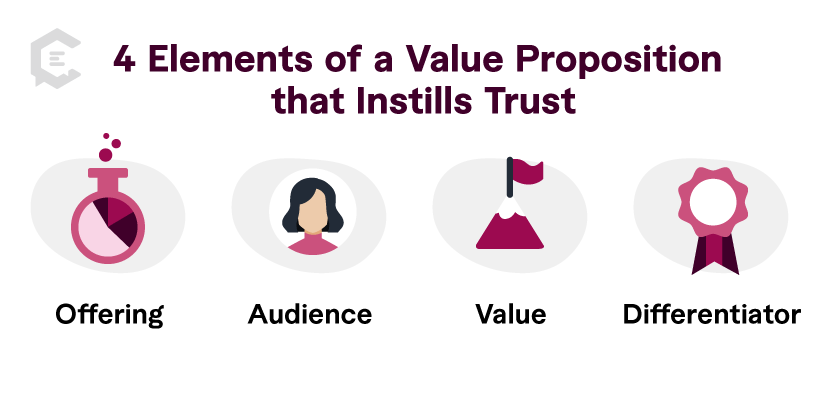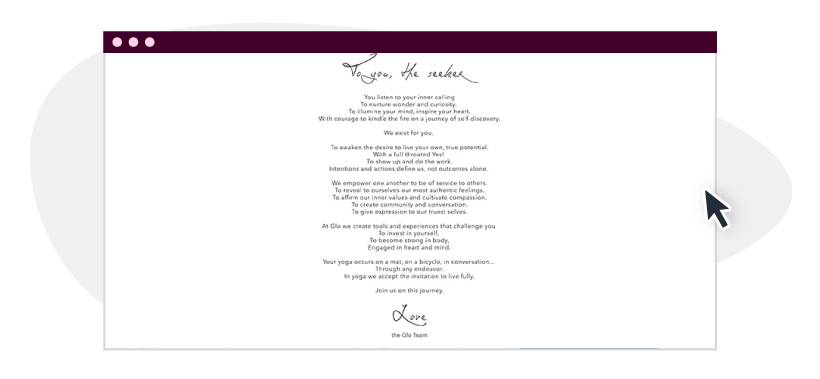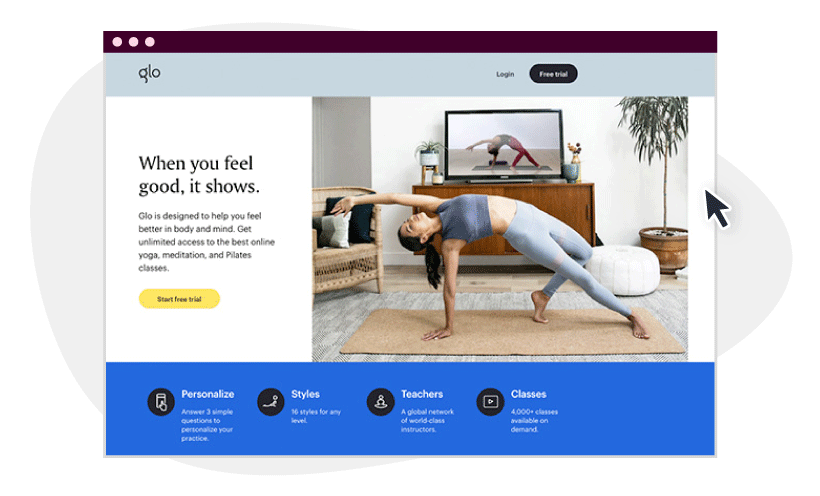What is a value proposition? A value proposition is a declarative statement that explains why a customer should purchase your product or service. It clearly explains what differentiates you, or makes your offering “unique,” and why you are the best choice on the market.
Value is a word that has nearly lost its meaning. This five-letter word has been overused and abused by brands across every messaging statement, across every website page, across every sales email. The way we do business has changed, and our messaging must change as well.
Brands that truly offer value to their customers — and communicate that value in a meaningful way — are the ones that will weather economic storms. Brands that demonstrate how they are uniquely positioned to meet buyer needs are the ones that will be noticed while their competitors are overlooked.
So, now is the time to do something about your unique value proposition. That starts by understanding its definition, the necessary elements, and how other experts and brands are executing them in a meaningful way.

What is a Value Proposition?
A value proposition (VP) is a declarative statement that explains why a customer should purchase your product or service. The statement summarizes how you will deliver your brand promise and how your offering will deliver value to customers. It clearly explains what differentiates you or makes your offering “unique” and why you are the best choice on the market.
When developing your value proposition statement:
- Don’t be vague or indirect, as your customer does not have time to dissect value positioning statements all day.
- Don’t spout off duplicitous messaging that does the opposite of conveying how you will deliver your promise by instead making promises your brand can’t keep.
- Do remember your competition is never far away when your customer needs a quick and convenient alternative.
Get to the point and appeal to your customer’s most pressing needs. Show why your offering is stronger than the competition so they can make an easy purchasing decision. Be honest and forthright to instill trust in your brand so your customer stays your customer long after the transaction. Serve, don’t sell.
The muse of your value proposition is your ideal customer (aka target audience). This is why, when developing your messaging, “customer value proposition” is an important synonymous term to keep in mind. Why should your customer buy from you — not one of your competitors? Your value prop should answer that question concisely in the voice of your customer.
Of all of the messaging statements out there, value propositions have perhaps the most variations with synonymous terms.
Value proposition synonyms include:
- Unique selling proposition (USP)
- Unique value proposition (UVP)
- Value proposition (VP)
- Value proposition statement
- Value prop
- Customer value proposition
- Brand value proposition
- Brand proposition
- Proposition of value
- Business value proposition
- Sales value proposition
- Product value proposition
- Value positioning
- Value statement
What a Value Proposition is Not
It’s common for content creators to use various messaging statements interchangeably because, frankly, there is a whole mess of statements to keep up with. Additionally, content is subjective. Content marketers have various styles, approaches, and definitions of various brand statements.
Being that the goal of a value prop is to create content that customers effortlessly connect with, you don’t want to cause confusion. The most common messaging mix-ups are brand statements and mission statements. Let’s clarify some things by detailing these messaging statements.
Value proposition vs. brand positioning statement
This is where the biggest mix-up occurs. If you squint your eyes just so, the words “proposition” and “position” look the same, even though they have completely different meanings. If someone uses “brand proposition” as a synonymous term for value proposition, then all hell breaks loose.
A brand positioning statement is a persuasive one-line statement that captures the reason the business exists and the legacy the brand wants to be remembered for. This internal-facing statement aligns your team around your brand’s purpose.
A value proposition focuses on your brand’s promise to deliver rather than your brand’s purpose of existence. A positioning statement is created from the value proposition to bring in the deeper “why” or essence of your brand.
Value proposition vs. mission statement
Confusion happens between mission statements and value propositions simply because the mission is a more prominent figure. A brand is much more likely to have an optimized mission statement… that they try to repurpose into other statements with different purposes.
A mission statement might appear on the About page of your website for all to see, but it is very much about the internal perception of the brand. Your mission defines what you do, and it is the core of your business. A unique value proposition is about external perceptions, and it clearly states why a customer should buy your product or service.
A value proposition can most certainly draw inspiration from your mission statement. In mere moments, we’ll explain and show how it can be an extension of your mission statement — and still maintain its structural integrity.
4 Elements of a Value Proposition that Instills Trust
At this point in the game, you have leveraged content to drive awareness of your brand and nurture existing and future customers. Then a wee pandemic comes along, and you don’t know where you stand anymore as a brand. Suddenly, trust and value play a more prominent role for all of us.
When making a big purchase, trust plays a major role for 92 percent of Americans, 89 percent of U.K. residents, and 95 percent of Canadians. Trust is perhaps another word we content marketers have exhausted as much as value. However, for customers to trust brands in today’s changing business environment, they must immediately recognize the value you offer.
It’s a good time to revisit your value proposition. Make sure you are staying relevant in uncertain times and presenting a solution that is responsive to your customer’s current needs.
The basic elements of a value proposition include the following:
- Offering: The product or service that solves problems/adds value. (WHAT)
- Audience: The ideal customer, or target audience, who will benefit from your offering. (WHO)
- Value: The recognizable benefits that matter most to the customer. (WHY)
- Differentiator: The reason the customer should trust you over someone else. (HOW)
Your unique value proposition needs to have meaning; otherwise, your customer will not connect with your brand or your offering. Without that connection, your customers will not have any foundation to build trust upon. Instead, they will turn toward someone else they feel they can trust, such as Competitors X, Y, or Z.
So… how do you write an effective value prop? Five experts in the branding and content marketing space shared their perspectives on what it takes to master the unique value proposition statement. Learn from tried-and-tested themes and templates they have developed — and see examples that bring more context to these strategies.
Value Proposition Examples: Extension of the Core Mission
A value proposition – done right – is an extension of your core mission, which shouldn’t change. For more than 20 years, our mission at Kinesis has been ‘Transformation.”
We help our clients transform their organizations, our employees to transform their careers, and our community to be a place of positive change. This one-word mission idea is the driving force in everything we do… think of it as our ‘why.’
Most folks don’t get this right, or they lean on clichés and platitudes, like ‘Integrity’ or ‘Excellence.’ However, once you get the mission right, then you can craft a meaningful value proposition that connects to your internal and external audiences — that’s your value proposition.
And, even better, when you know what your mission is, you can adapt and change your value proposition and business model to meet any new challenge. That’s especially important as we enter a time of certain uncertainty.
— Shawn Busse, CEO/Founder, Kinesis
TOMS Shoes value proposition
When you’re buying apparel, it can feel pretty meaningless, right? Yet, TOMS Shoes turned purchasing shoes into a way to make progress. Using its One for One business model, for every pair of TOMS shoes purchased by a customer, the company provided a pair of shoes to a child in need.
Just last year, TOMS moved away from its one-for-one model to instead give a third of its net profits to the company’s giving fund. During COVID, the donations have been redirected to support organizations on the frontlines.
The name TOMS is short for Tomorrow’s Shoes. Improving lives and communities are the heart and soul of the TOMS mission statement. This company doesn’t just use their value proposition as an extension of their mission, they also extend their philanthropic nature into all aspects of the business. And, their customers get to be a part of that.
Value Proposition
Improve the lives of millions of people around the world while creating a for-profit sustainable business model, based on a fashionable product for aware consumers.
- Offering: Shoes
- Audience: Conscious consumers
- Value: Giving back with every purchase
- Differentiator: Improving lives and communities
Value Proposition Examples: Short, Punchy, and Powerful
In my agency life and as a freelance writer, I’ve had to write a value prop for a client or two along the way. Whether for a website rewrite or a complete rebranding, it always comes down to one thing: Saying the most powerful thing possible in the fewest amount of words.”
In that vein, my No. 1 goal is to first identify what makes this client’s product or service most unique when held up against their competitors. Oftentimes, that means researching the competition to make sure I’m positioning this business in a way where they’ll stand out successfully — not just sound like the rest.
Once that element (or elements) is identified, keeping it short and sweet is always my next goal. Because if you can’t express what makes your client different in a short, punchy, and powerful way, then you’re missing the most important chance to connect with customers right from the start.
—Gregg Rosenzweig, Writer/Creative Director, GR ink
Glo value proposition
Working out from home has suddenly become the new normal. Glo (formerly known as YogaGlo) launched in 2007, long before subscription-based online fitness classes were a thing.
Convenience and expertise are big perks for busy wellness enthusiasts. Glo subscribers take unlimited classes virtually for the cost of a single studio class. This has always been Glo’s differentiator in the wellness space, as their model makes yoga widely accessible. Throughout COVID, they have provided a selection of free classes as well.
Glo has an entire manifesto that incorporates its mission and vision statements…
…yet Glo keeps its value proposition short, punchy, and powerful while demonstrating how its unique business model helps it stand out in the wellness market.
Value Proposition
Thousands of classes at our customers’ fingertips. World-class teachers. A subscription that costs less than one class a month. Anytime, anywhere…
- Offering: Online yoga, meditation, and Pilates classes
- Audience: Wellness-conscious consumers
- Value: Unlimited access to reasonable on-demand classes with expert instructors
- Differentiator: Practicing wherever and whenever.
Value Proposition Examples: Delivering With Distinction
The purpose of a unique value proposition (UVP) is to clearly articulate a brand pillar that is defined during the brand development process.
In my first draft, I always start the sentence with ‘only’ and the brand name as a reminder the statement must be a claim of distinction in the market. After the first round of reviews with the client, I often edit that out because it’s implied. The rest of the sentence defines ‘what’ the brand delivers, ‘how’ that is unique in the market, and ‘why’ that matters to the customer.
A final statement might look like this: ‘The XYZ experience is crafted to delight our customers and their clients, creating lasting and profitable relationships.’
Finally, I always list current proof points that make the statement true today, along with future-looking ideas that will make the delivery of that promise even stronger down the road. A value proposition should always have room for growth as it drives decision-making in the company to consistently deliver a brand promise to the customer.
— Grant Kimball, Certified Brand Strategist, Brand Incite
Alaska Airlines value proposition
Humor me for this next value proposition discussion, as we harken back to pre-COVID times when we all used to travel by plane. Flying is a royal pain in the ass, and we just want to safely get from Point A to Point B. It’s not common to hear people say they love an airline. But, I’ve said “I love Alaska” many, many times.
This is what makes Alaska so distinct — and what makes them stand out from other airline carriers. Passengers legitimately love this airline. People who fly on Alaska can actually agree with their tagline: “Fly Smart. Land Happy.” They are delivering on their brand promise to their customers.
Alaska Airlines focuses on being a socially responsible company that is all about quality and care. In the midst of the COVID pandemic, Alaska’s home page demonstrates their commitment to relationships in being “on the journey together.” They put their customers at ease with the second section of the page, which has a slideshow with safety and wellness features.
Value Proposition
Low fares, great service, and a range of cabin options are the foundation of our offering. The Alaska experience centers around building long-term relationships with our guests.
- Offering: Plane tickets
- Audience: Passengers, primarily those flying between West Coast destinations
- Value: Low fares, great service, range of cabin options
- Differentiator: Long-term relationships
Value Proposition Examples: Voice the Value
When a content marketing client asks me to write a value proposition statement for their website — perhaps on a landing page or a product page — I immediately review their branding documents. What tone should I take? Conversational and friendly, or business professional and straightforward?
Then I look to the company’s mission statement and product descriptions to discover their core values and the benefits of what they sell so I can highlight those in their value proposition statement. I strive for being relatable and concise to keep viewers on the page, intrigued and informed.
— Angela Tague, Content Marketing Writer and Founder, Web Writing Advice
Zoom value proposition
Raise your hand if you’ve been on a Zoom call this month. How about this week? Everything from birthday celebrations to live educational classes — along with a substantial uptick in virtual meetings and events — is now happening on Zoom.
“With any other solution, I spent a great deal of time trying to start the conference, let alone maintain it. Zoom has made the experience of collaborating with people as simple as clicking on a link and zipping right into the conversation.”
Zoom is on a mission to make video communications frictionless. The aforementioned testimonial by Dr. Joseph Morgan, Texas A&M University validates their platform’s ease of use.
As communication has shifted from in-person to digital environments, Zoom has become a huge value-add for people who want to stay connected and have some semblance of face-time during COVID. The “frictionless” value is clear, as people who have never used Zoom before are rapidly well-versed in the platform.
Value Proposition
Zoom helps businesses and organizations bring their teams together in a frictionless environment to get more done.
- Offering: Video communication platform
- Audience: Enterprise teams in finance, education, healthcare, and government
- Value: Connect and accomplish more
- Differentiator: Frictionless or “easy to use”
Value Proposition Template: Content Mission Statement
Lastly, I will leave all of you content marketers in good hands… with Andy Crestodina. Your content mission statement is a type of value proposition — one that is very often forgotten by busy content creators. Andy shares his thoughts and a useful value prop template…
How do you write an effective value proposition? This makes me think of a specific type of value proposition: the content mission statement.
The value prop for your content (also known as the content marketing mission statement) is an important foundation for content strategy. If you haven’t made yours yet, you can use this handy template…
Our company is where [audience X] finds [content Y] for [benefit Z].
It’s important partly because it keeps the marketer focused, but also because it can be repurposed into a killer call to action. Your email signup box is basically a simplified version of this. It uses the [content Y] and sometimes the [benefit Z]. The highest converting ‘email subscribe’ CTAs are just versions of the content value proposition.
— Andy Crestodina, Co-Founder/Chief Marketing Officer, Orbit Media
Creating Your Value Proposition
Albert Einstein’s words continue to be relevant a hundred years after his time: “Strive not to be a success, but rather to be of value.”
By striving for success, you fall into the brand camp that exhaustively weaves the word “value” into every possible opportunity — so that the word eventually loses its meaning. By focusing on being of value, you show value without needing to talk about it. Rather than having a value proposition that has no meaning, you have a meaningful statement instead.
Creating a value proposition statement is yet another creative chance to use the “show, don’t tell” approach to writing. String together words that create an immersive experience for your intended audience. When you allow your audience to be in the room, you establish credibility and connectivity… and invite them to stay and do business with you.
Need help creating your value proposition? Look no further. ClearVoice has your back. Easily speak with a content specialist today regarding your needs, wants, and content goals.











